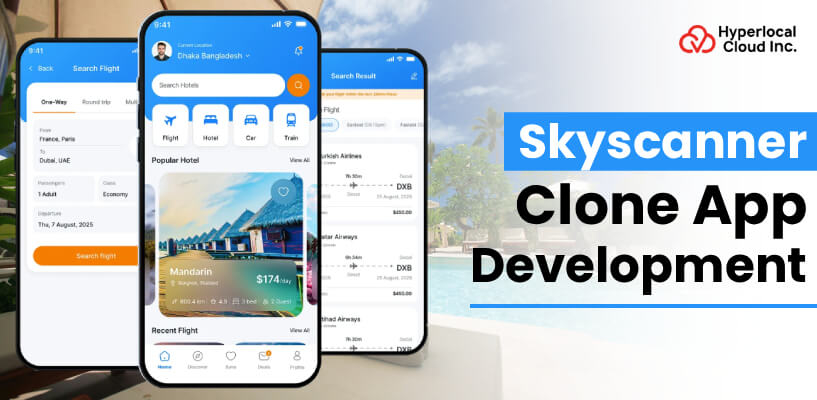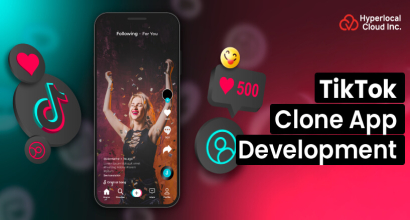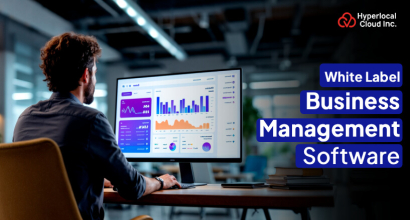A digital transformation of the travel industry has predetermined the emergence of flight comparison apps as a necessity among modern travelers. The reason why businesses are investing heavily in Skyscanner-like applications is that they are accessing lucrative markets where they can make more than one stream of revenue, affiliate commissions, advertising, and premium partnerships, and they do not have to worry about managing inventories. These sites provide business models that are scalable to the billion-dollar travel technology industry.
The worldwide online travel booking sector is estimated to be $1.2 trillion by the year 2030, and mobile booking is expected to do more than 60% of the reservations. The travel rebound has increased the speed of demand since the metasearch engines are processing millions of searches per day, with consumers focusing on flexibility and affordability options when planning travel.
What Is A Skyscanner App?
Skyscanner is one of the popular applications, which combines flight, hotel, and car rental services of hundreds of travel agents around the globe. Instead of providing direct sales, it will compare prices among airlines, online travel agents, and booking systems and redirect the traffic to final purchases.
The application will enable traveling individuals to discover the most optimal deals using flexible search options, price notifications, and everywhere search options, enabling it to be a full-scale travel planning application to be used by budget-conscious travelers.
To develop a transport booking app or an app like Skyscanner, read on below to know more.
Working Model Of The Skyscanner Clone App
The Skyscanner clone app works with a simplified system enabling the integration of travelers with the most favorable flights through various providers. The following is a stepwise description of the operation of the application:
Step 1: User Input and Search Query
The user types in their travel needs, such as the origin, the destination, dates of the travel, passenger numbers, and the cabin class, in a user-friendly interface. The app is also capable of giving a flexible search feature, such as anywhere destinations or whole month vistas, and this will enable those on a low budget to find out what is cheapest they can get.
Step 2: Real-Time Data Aggregation
The application also makes requests on hundreds of connected sources, such as airlines, online travel agencies, and global distribution systems, using API connections. It takes only a few seconds to handle the real-time pricing, availability, flight schedules, and route information and put it together in a similar, comparable format.
Step 3: Results Processing and Display
Data that is collected is sorted using sorting algorithms that sort the flights by price, duration, departure time, or optimal value in a clean interface. The application presents the main information, such as the time of journey, destinations, airline companies, and price, in visual formats such as color-coded signs that may be easily examined.
Step 4: Filtering and Refinement
With the help of artificial filters, users can filter by direct flights, airline preference, departure dates, length of journeys, baggage limits, and stops. The application is dynamic and displays results dynamically when filters are applied, and only relevant ones are displayed without the necessity to search again.
Step 5: Comparison and Selection
The application allows simultaneous comparison of flight deals, which shows the disparities in prices, the time spent on the layover, and the overall time of the trip. Detailed itineraries, airline policies, baggage information, and reviews are available to the users, and price history graphs provide an informed choice.
Step 6: Redirection to Booking
Once the users choose the flight of their choice, the app will redirect them to the travel provider's site, where they can see all the flight details. This is a referral-based commission-earning scheme that requires minimal operational complexity, as the clone app does not deal with payments or booking administration.
Start building your Skyscanner-like app today!
What Makes Investing In A Skyscanner Clone App A Good Move?
Investing in a travel booking app like Hopper or Skyscanner clone is a business opportunity with considerable benefits to organizations that want to join the profitable travel technology industry. Here are the most important advantages that will make this investment worthwhile:
1. Multiple Revenue Streams
The application makes revenue on a cost-per-commission (CPC) and cost-per-acquisition (CPA) basis, inclusive of affiliate deals with travel providers. Sponsored listings, display advertisements, and premium subscription features provide additional revenue and are a source of diversified, sustainable income.
2. Low Operational Costs
The app does not have inventory control, flight tickets, or customer service to effect transactions, which is unlike traditional travel agencies. The platform is a mediator that saves a lot of overhead and has a high profit margin as automated systems are used.
3. Scalable Business Model
Cloud-based infrastructure also enables the app to perform millions of searches at once without corresponding cost expansion. The digital attribute allows easy market expansion, provision of other facilities such as hotels and car rentals, and a global presence without a physical presence.
4. High User Demand
The online travel industry is rapidly expanding across the world, and more and more travelers use the services of comparison platforms prior to making a reservation. Mobile-first consumers favor applications that facilitate the decision-making process, which would guarantee the user traffic and participation in the business in the long run.
5. Minimal Entry Barriers
Ready-made clone solutions save on the time and costs involved in building them, which will enable quicker entry to the market. Ready-made systems have a set of key features, APIs, and integrations, and they allow companies to start fast and gain market share in the most effective way possible.
Key Features Of A Skyscanner Clone App
An effective Skyscanner clone app should have extensive features for both users and administrators so that it functions smoothly and management is done efficiently. The following is a summary of the key aspects that each panel should have:
User Panel Features
1. User Registration and Login
Users are able to make personal accounts on email, phone number or social media accounts, so as to access personalized features and preferences.
2. Advanced Search Functionality
Fill in the origin, destination, dates, passengers, and cabin class, and include flexible features such as the view of anywhere and the view of the whole month.
3. Real-Time Flight Comparison
It's a piece of cake for customers to do a price comparison of flights, check the availability, and schedule flights not only among airlines but also among OTAs.
4. Smart Filters and Sorting
The smart filtering feature will narrow down the search for the users with the price range, stops, airlines, departure times, duration, baggage allowance, and aircraft type filters.
5. User Reviews and Ratings
The paid traveler will be able to read through the written reviews and ratings by other travelers on the same airlines, same routes, and even on their booking experience, thereby enabling them to make an informed decision.
6. Booking History and Management
Easily browse through all the flights searched, saved itineraries, and redirection of bookings with the help of access to past searches and preferences.
7. Multi-Currency and Language Support
See prices in the local currencies and use the application in a variety of languages to get localized experiences that are user-friendly.
8. Direct Booking Redirection
Easily redirect to the airline or OTA websites with pre-filled flights to complete the booking without any hassles.
9. Price Comparison Widgets
Compare prices of other airlines on the same flight with transparent payments in terms of taxes, charges, and overall costs.
10. Customer Support Chat
Live chat, chatbots, or help center access to in-app customer support by asking questions and seeking advice.
Vendor/Partner Panel Features
1. Partner Registration
The airlines and OTAs' feature allows vendors the opportunity to create a business account by completing their profile, adding the company description, their certifications, and the services they offer.
2. Inventory Management
Using the inventory management feature, the vendors can import and manage flight schedules, pricing, and availability, and can update all the connected platforms.
3. Commission Dashboard
Vendors can quickly check their earnings, bookings, and payment history using the commission dashboard. They can break down the revenue by route, date, and booking source, which will provide them with financial transparency.
4. Performance Analytics
The performance analytics feature helps vendors to measure their conversions, clicks, and ROI of the platform listing. They can view the traffic, performance metrics, and user interest and compare them to their competitors using the visual charts.
5. Sponsored Listing Management
Vendors can buy and operate sponsored placements that have maximum views in the search results. They can manage the budget limits, bid flexibility, and the time required to run the campaign.
6. Pricing Updates
Using the pricing updates feature helps vendors update the prices in real-time and marketing deals by using the automated API feeds and the user-friendly interface. This will allow vendors to be in touch with the market.
7. Booking Reports
Booking reports help vendors view their booking data on the platform. This booking data includes the route activity, information of the passenger, customer profile, and seasonal view, which can be utilized in developing the strategy.
8. Marketing Tools
The vendors can use different marketing tools, which will help them to offer special deals and promotions to their users. They can develop customizable discount codes and limited-time offers, which are based on users' preferences.
9. API Documentation
The API documentation will include the sample codes, endpoint descriptions, and descriptions related to the authentication protocols. There are several other details that help vendors to easily onboard.
10. Payment Settings
By using the payment settings feature, vendors can organize payment options, multiple currencies, automated invoicing, tax settings, and easy withdrawal options to offer financial conveniences.
Admin Panel Features
1. Dashboard and Analytics
An elaborate dashboard reflecting the major metrics like searches, bookings, revenue, active users, and traffic sources, along with their numbers, is provided.
2. User Management
Manage, view, edit, suspend, or delete user accounts that have access to user profiles, history of activity, and engagement patterns.
3. Flight Data Management
Monitor flight data feeds in real time, maintain airline data, maintain route databases, and make sure that pricing is correct across providers.
4. Commission and Revenue Tracking
Monitor the earnings of CPC, CPA models, and affiliate programs with specific reports of revenue per provider and campaign.
5. Search Analytics and Insights
Use trends in routes, destinations in demand, busiest times of the day, and user behavioral patterns to guide the business strategy.
6. Pricing and Promotion Management
Create sponsored placements, operate featured placements, control advertising campaigns, and organize promotional deals among providers.
7. Notification Management
It will include the design as well as scheduling of push, email, and SMS messages regarding price reductions, promotions and updates to the application.
8. Review and Rating Moderation
Monitor, approve, or remove user reviews and ratings to ensure quality standards and to avoid spam or other inappropriate material.
9. Payment Gateway Configuration
Install and control payment processing systems on premium features, subscriptions, or direct booking services where applicable.
10. Customer Support Management
Support tickets, chat conversations, user queries, and the FAQ database are to be effectively handled.
11. Performance Monitoring
Enhancing by watching the measures of the performance of the application, like load time, API response time, server downtime, and error logging.
Advanced Features That Will Help Your Skyscanner Clone Stand Out
Artificial intelligence will make the Skyscanner clone app an intelligent travel assistant, which provides personalized, predictive, and efficient services. The following are the key AI-based capabilities:
1. Intelligent Price Prediction
With the help of AI algorithms, previous prices, season, and the scheme of booking are analyzed to make predictions about the next change of fares with high precision. The system will inform the user what the best time is to book and whether the prices will increase or decrease in the future.
2. Personalized Travel Recommendations
Machine learning algorithms examine the search history, preferences, and booking history of users to propose destinations, routes, and travel dates that match the preferences of each user. This system learns every time, and as user needs and budget changes, this system suggests better and better.
3. Smart Search Optimization
The search algorithms powered by AI can comprehend human language queries and intent, and provide relevant information with vague or undefined search parameters. The system lays emphasis on results depending on the preferences of the users, their prior activity, and situational considerations such as the position of the device and when they are using the search engine.
4. Chatbot and Virtual Assistant
The chatbot is an AI-based instant customer service answering queries related to booking, travel policies, baggage, and destination 24/7. The virtual assistant serves to service sophisticated conversations, fixes problems, and takes the user through the search and booking process with human-like interactions.
5. Dynamic Pricing Alerts
Machine learning systems track the real-time price fluctuations of thousands of routes and forecast the occurrence of particular prices to reach user-determined threshold values. The system will provide proactive alerts that come with confidence scores, and this enables the users to get the best deal before the price goes higher or the supply runs out.
6. Fraud Detection and Security
AI algorithms process the data on user behavior and transactions, as well as booking operations, and recognize suspicious activity and possible fraudulent accounts in real-time. The system is configured to automatically identify anomalies, block unauthorized access, and shield the user and the system against threats to security.
Launch your own travel marketplace at an affordable cost
Steps To Develop An App Like Skyscanner
The Skyscanner clone app development has to be done in a methodical manner that is capable of delivering functionality, scalability, and satisfaction to the user. The simplified four-step process of development is as follows:
Step 1: Market Research and Planning
In the first step, the team of developers will sit down with the business person to emphasize the need for the market analysis in the identification of their target market, the nature of their competitors, as well as the value propositions of their travel application. Suitable records should be created to determine the scope of the app. This will include the feature definition of the functionalities they want to integrate into the app, technical specifications, monetization, timelines, and budget estimates.
Step 2: UI/UX Design and Prototyping
The second step involves the designers creating a user interface that is simple and user-friendly by means of prototypes and wireframes, which represent user-friendliness, visuals and mobile phone usage. Build an interactive prototype of user and administrator interfaces in a way that is adequately branded, accessible, and with easily searchable sequences.
Step 3: Development Phase
In this step, a team of developers starts working on building the app. There are two ways in which developers choose to develop the application. One is a white-label and the other is a custom-based app solution. The table below shows the difference between the two:
| Aspect | Custom-Based Solution | White Label Solution |
| Development | Built from scratch for specific needs | Pre-built, rebrandable product |
| Time to Market | 6-12+ months | Days to weeks |
| Cost | High initial investment | Low upfront cost, subscription model |
| Customization | Fully flexible, unlimited changes | Limited to existing features |
| Ownership | Complete code ownership | Licensed, vendor-dependent |
Step 4: Testing, Deployment, and Maintenance
After the application is developed successfully, the testers will test the application to find bugs in the app. They will ensure that bugs have been fixed prior to the release of the app. After testing, the app can be released on different platforms, such as the Google Play Store and Apple App Store. The part here doesn't stop; companies have to keep track of the app's performance, take reviews, and thus, they can give regular updates, new features, and improvements to the users.
Technologies Used In Developing The Skyscanner Clone App
The following are the technologies that businesses can use when developing an app like Skyscanner.
| Category | Technologies |
| Frontend Development | React.js, Angular, Vue.js |
| Mobile Development | React Native, Flutter, Swift (iOS), Kotlin (Android) |
| Backend Development | Node.js, Python (Django/Flask), Ruby on Rails, Java |
| Database Management | MongoDB, PostgreSQL, MySQL, Redis |
| Cloud Infrastructure | AWS, Google Cloud, Microsoft Azure |
| API Integration | RESTful APIs, GraphQL |
| Push Notifications | Firebase Cloud Messaging, OneSignal |
How To Make Money Through A Skyscanner Clone Without Turning People Off
An application like Skyscanner uses several monetization strategies to build a sustainable and profitable business model. The three main sources of revenue are the following:
1. Commission-Based Revenue
This is the main source of revenue since the app receives a percentage of all flights, hotels, or car rentals booked via the platform in collaboration with airlines and other travel providers. Also, optional services such as seat upgrades, extra baggage, travel insurance, and other additions have small transaction fees attached to them and are offered to the users during the booking process.
2. Advertisement and Partnerships
Placement of specific advertisements by travel-related partners (Hotels, Luggage companies, insurance companies, etc.), which will earn the company revenue when clicks are made and lead conversions are made. The travel providers pay for featured listing and first placement in search results to gain more visibility, whereas affiliate marketing relationships with travel agencies receive more commissions with the successful referral.
3. Premium and Value-Added Services
The subscription plans provide the premium effect, such as first-mover deals, ad-free user experience, top priority customer support, and customized travel advice at a regular price. The site also makes profits through the development and sales of package offers, which include flights, hotels, and cars at matched prices with reasonable margins.
Launch your own travel marketplace in just a few clicks
Development Cost To Build An App Like Skyscanner
Developing a travel activity booking app will roughly cost you around $5,000 for the first level. The total travel app development cost, however, depends on quite a few factors, the main one being the choice of the development process. Besides that, application complexity, team geolocation, skills, market size, AI-powered technologies, and third-party integrations are some of the essential factors that can increase the cost of development.
Launch Your Own Skyscanner Clone With Hyperlocal Cloud
Your business will greatly benefit from partnering with Hyperlocal Cloud when you want to launch your own travel marketplace app. Below are the reasons that basically show you why investing and trusting us will yield great results for your business.
1. Tailored and White-Label Offerings
We are a team of professionals who are fully competent in the provision of white label solutions, which implies that you can change the app to your explicit needs and also the identity of the brand. It gives a company the opportunity to maintain continuity and provide a personal experience to its users without the need to start from scratch.
2. Deep Expertise in Travel Industry Solutions
We at Hyperlocal Cloud understand the travel industry better, as we have years of experience in developing travel applications for several businesses and startups. Our team is skilled and builds easy-to-use solutions that help clients achieve their business goals.
3. Proven Results and Client Success Stories
Hyperlocal Cloud has built a strong reputation for quality application distribution that leads to customer success, as evidenced by the history of project distribution in the travel and hospitality sector.
4. Seamless AI Technology Integration
By focusing on AI-operated solutions, we make sure that your platform is capable of using the latest technology for future analysis, personalization, and dynamic prices. Once you are equipped with AI, you can make the users more productive, optimize price models, and enhance the whole ordering experience.
5. Engineered for Scalability and High Performance
We realize the challenge of scalability in the travel sector. The development solutions we use will ensure that your platform can continue to handle increased user traffic and transactions and that you will be ready for the high season or rapid growth.
To launch your own travel marketplace, reach out to us today



